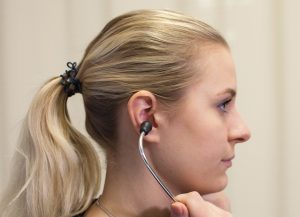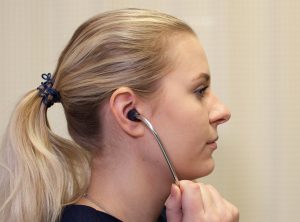Chapter 5: Blood Pressure
Test Yourself – Answers
1. Watch and listen to Korotkoff sounds while blood pressure is taken in audio clip 5.2. What is the systolic and diastolic blood pressure?
104/84 mm Hg
(NOTE: you should aim to obtain a measurement within 2-4 mm Hg. In this testing environment, it may depend on the quality of your computer speakers. In actual practice, the stethoscope’s quality is a main determinant of accuracy)
2. Watch and listen to the Korotkoff sounds while blood pressure is taken in audio clip 5.3. What is the systolic and diastolic blood pressure?
118/76 mm Hg
(NOTE: you should aim to obtain a measurement within 2-4 mm Hg. In this testing environment, it may depend on the quality of your computer speakers. In actual practice, the stethoscope’s quality is a main determinant of accuracy)
3. Which one of the two images below (Figure 5.5 or Figure 5.6) demonstrates the correct way of putting the ear pieces of the stethoscope in your ears?
 The correct way
The correct way

Figure 5.5: Stethoscope in the ears the correct way
 The incorrect way
The incorrect way

Figure 5.6: Stethoscope in the ears the incorrect way
Rationale: The slope of the stethoscope’s ear pieces are inserted at the same angle as the ear canal (e.g., pointing forward or pointing toward the nose) as shown in Figure 5.6. The action shown in 5.7 is incorrect as the ear pieces are pointed straight into the ears.
4. True or False: The bell of the stethoscope is best used to hear Korotkoff sounds.
Rationale: The correct answer is true. You can use the bell or diaphragm to take a blood pressure, but the best way to hear the Korotkoff sounds is with the bell because it is better at picking up low-pitch vascular sounds.
5. In a blood pressure measurement of 110/70, the first number is the ________.
a. systolic pressure **
b. diastolic pressure
c. pulse pressure
d. mean arterial pressure
(from OER#2)
Rationale: The correct answer is a (systolic pressure). When documenting the blood pressure, the first sound heard is the systolic pressure and the last sound heard is the diastolic pressure. Thus, the systolic measurement is reported as the numerator.
6. A healthy elastic artery ________.
a. is compliant **
b. reduces blood flow
c. is a resistance artery
d. has a thin wall and irregular lumen
(From OER#2)
Rationale: The correct answer is a (is compliant). Arteries are able to expand and contract to adjust to pressure and volume changes.
7. Which of the following symptoms may be a result of orthostatic hypotension?
a. Fatigue
b. Nocturia
c. Dizziness **
d. Chest pain
Rationale: The correct answer is c (dizziness). With orthostatic hypotension, the blood vessels fail to constrict effectively when the client moves to an upright position. This causes a decrease in blood flow to the brain.
8. The healthcare provider assesses an older client’s blood pressure for the first time at a walk-in clinic. The healthcare provider obtains a reading of 164/84. What should the healthcare provider do first?
a. Take the client’s pulse
b. Provide education to the client
c. Inform the most responsible provider
d. Repeat the blood pressure on the other arm **
Rationale: The correct answer is d (repeat the blood pressure on the other arm). An abnormal blood pressure needs to be repeated to determine accuracy before making a clinical decision.
9. A woman’s pre-pregnancy pulse and blood pressure are 72 bpm and 112/78. Which findings are of most concern to the healthcare provider?
a. Pulse 82 bpm and BP 108/70 at the end of the first trimester
b. Pulse 68 bpm and BP 118/82 in the first half of the first trimester
c. Pulse 90 bpm and BP 104/68 at the beginning of the second trimester
d. Pulse 90 bpm and BP 138/88 towards the latter half of the final trimester **

